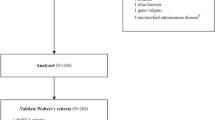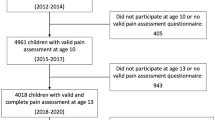Abstract
The term 'growing pains' has been used for almost 200 years to refer to the often severe, generally bilateral lower-extremity nocturnal pains experienced by up to one-third of all children at some time during early childhood. No clear mechanism has yet been identified that explains these pains, but there is an increasing body of evidence indicating that several factors, individually or in combination, might be responsible for this phenomenon. These include mechanical factors, such as joint hypermobility and flat feet, decreased pain thresholds, reduced bone strength, and emotional factors involving the patient's family and other social stressors. Correct diagnosis of growing pains requires a thorough patient history and physical examination. The diagnosis can be safely established without unnecessary laboratory investigations or imaging; however, identification of one or more clinical cautionary signs, such as unilateral pain, morning stiffness, joint swelling and systemic symptoms (e.g. fever, weight loss and malaise), should trigger an extended evaluation to exclude other more serious conditions that might also present with limb pain. Once the diagnosis has been established, conservative management, using symptomatic pain medications, massage and other supportive measures, should be employed until the syndrome self-resolves with time.
Key Points
-
The term 'growing pains' is a misnomer, describing a common, benign, noninflammatory pain syndrome of early childhood that usually resolves with time, without specific treatment
-
Growing pains is a clinical diagnosis based on characteristic features of nonarticular, bilateral pain, mainly in the lower extremities, that occurs mainly in the evening or night with resolution of pain by morning and a normal physical examination; patients fulfilling these criteria do not need to undergo further evaluation
-
Patients with features that do not fit the typical description of growing pains need to be evaluated carefully for an alternative diagnosis
-
While the etiology is still unknown, factors that influence growing pains include overuse, decreased pain threshold, decreased bone strength, anatomical or mechanical features and family dynamics
This is a preview of subscription content, access via your institution
Access options
Subscribe to this journal
Receive 12 print issues and online access
$209.00 per year
only $17.42 per issue
Buy this article
- Purchase on SpringerLink
- Instant access to full article PDF
Prices may be subject to local taxes which are calculated during checkout
Similar content being viewed by others
References
Oster J and Nielsen A (1972) Growing pains. A clinical investigation of a school population. Acta Paediatr Scand 61: 329–334
Uziel Y and Hashkes PJ (2007) Growing pains in children. Pediatr Rheumatol 5: 5
Hashkes PJ et al. (2004) Decreased pain threshold in children with growing pains. J Rheumatol 31: 610–613
Hashkes PJ et al. (2005) “Growing pains” in children are not associated with changes in vascular perfusion patterns in painful regions. Clin Rheumatol 24: 342–345
Duchamp M (1823) Maladies de la croissance. In Memoires de medicine pratique (Ed. Levrault FG) Paris: Jean-Frederic Lobstein
Bennie PB (1894) Growing pains. Arch Pediatr 11: 337–347
Sheldon WPH (1936) Diseases of infancy and childhood. London: Churchill
Hawksley J (1938) The incidence and significance of growing pains in children and adolescents. R Inst Public Health Hyg J 1: 798–805
Seham M and Hilbert EH (1933) Progress in pediatrics: muscular rheumatism in childhood. Am J Dis Child 46: 826–853
Hawksley J (1939) The nature of growing pains and their relation to rheumatism in children and adolescents. Br Med J 1: 155–157
Hawksley J (1931) Race, rheumatism, and growing pains. Arch Dis Child 6: 303–306
Naish JM and Apley J (1951) “Growing pains”: a clinical study of non-arthritic limb pains in children. Arch Dis Child 26: 134–140
No authors listed (1951) Growing-Pains. BMJ 2: 1452
Durand CH (1963) Some problems in current practice. So-called “growing” pains, scoliotic postures and length inequalities of the lower extremities [French]. Sem Hop 39: 1142–1145
Apley J (1970) Clinical canutes. A philosophy of paediatrics. Proc R Soc Med 63: 479–484
Williams MF (1928) Rheumatic conditions in school-children: an investigation into growing pains and nodules (grains). Lancet 211: 720–721
Brenning R (1960) Growing pains. Acta Soc Med Ups 65: 185–201
Evans AM and Scutter SD (2004) Prevalence of “growing pains” in young children. J Pediatr 145: 255–258
Brenning R (1960) “Growing pains” [Swedish]. Sven Lakartidn 57: 85–103
Shapiro MJ (1939) Differential diagnosis of nonrheumatic “growing pains” and subacute rheumatic fever. J Pediatr 14: 315–322
Abu-Arafeh I and Russell G (1996) Recurrent limb pain in schoolchildren. Arch Dis Child 74: 336–339
Mikkelsson M et al. (1997) Non-specific musculoskeletal pain in preadolescents. Prevalence and 1-year persistence. Pain 73: 29–35
Oberklaid F et al. (1997) “Growing pains”: clinical and behavioral correlates in a community sample. J Dev Behav Pediatr 18: 102–106
van Dijk A et al. (2006) Pain prevalence in nine- to 13-year-old schoolchildren. Pain Res Manag 11: 234–240
de Inocencio J (2004) Epidemiology of musculoskeletal pain in primary care. Arch Dis Child 89: 431–434
Buskila D et al. (1993) Assessment of nonarticular tenderness and prevalence of fibromyalgia in children. J Rheumatol 20: 368–370
Yunus MB and Masi AT (1985) Juvenile primary fibromyalgia syndrome. A clinical study of thirty-three patients and matched normal controls. Arthritis Rheum 28: 138–145
Friedland O et al. (2005) Decreased bone speed of sound in children with growing pains measured by quantitative ultrasound. J Rheumatol 32: 1354–1357
Aromaa M et al. (2000) Pain experience of children with headache and their families: a controlled study. Pediatrics 106: 270–275
Evans AM (2003) Relationship between “growing pains” and foot posture in children: single-case experimental designs in clinical practice. J Am Podiatr Med Assoc 93: 111–117
Baxter MP and Dulberg C (1988) “Growing pains” in childhood—a proposal for treatment. J Pediatr Orthop 8: 402–406
Sherry DD (2000) An overview of amplified musculoskeletal pain syndromes. J Rheumatol Suppl 58: 44–48
Palermo TM (2000) Impact of recurrent and chronic pain on child and family daily functioning: a critical review of the literature. J Dev Behav Pediatr 21: 58–69
Uziel Y et al. (2007) Living with children with growing pains: how does it affect the parents? J Musculoskel Pain 15: 19–23
Evans AM et al. (2006) “Growing pains” in young children: a study of the profile, experiences and quality of life issues of four to six year old children with recurrent leg pain. The Foot 16: 120–124
Apley J (1958) A common denominator in the recurrent pains of childhood. Proc R Soc Med 51: 1023–1024
Oster J (1972) Recurrent abdominal pain, headache and limb pains in children and adolescents. Pediatrics 50: 429–436
Asadi-Pooya AA and Bordbar MR (2007) Are laboratory tests necessary in making the diagnosis of limb pains typical for growing pains in children? Pediatr Int 49: 833–835
Peterson HA (1977) Leg aches. Pediatr Clin North Am 24: 731–736
Passo MH (1982) Aches and limb pain. Pediatr Clin North Am 29: 209–219
Gedalia A et al. (1993) Joint hypermobility and fibromyalgia in schoolchildren. Ann Rheum Dis 52: 494–496
de Inocencio J (1998) Musculoskeletal pain in primary pediatric care: analysis of 1,000 consecutive general pediatric clinic visits. Pediatrics 102: E63
Bowyer SL and Hollister JR (1984) Limb pain in childhood. Pediatr Clin North Am 31: 1053–1081
Picchietti DL and Stevens HE (2007) Early manifestations of restless legs syndrome in childhood and adolescence. Sleep Med [10.1016/j.sleep.2007.08.012]
Rajaram SS et al. (2004) Some children with growing pains may actually have restless legs syndrome. Sleep 27: 767–773
Walters AS (2002) Is there a subpopulation of children with growing pains who really have Restless Legs Syndrome? A review of the literature. Sleep Med 3: 93–98
Walters AS et al. (1994) Restless legs syndrome in childhood and adolescence. Pediatr Neurol 11: 241–245
Picchietti D et al. (2007) Restless legs syndrome: prevalence and impact in children and adolescents—the Peds REST study. Pediatrics 120: 253–266
Chapnik G et al.: Bone strength in children with growing pains as measured by quantitative ultrasound—an outcome study [abstract]. Turk J Pediatric, in press
Author information
Authors and Affiliations
Corresponding author
Ethics declarations
Competing interests
The authors declare no competing financial interests.
Rights and permissions
About this article
Cite this article
Lowe, R., Hashkes, P. Growing pains: a noninflammatory pain syndrome of early childhood. Nat Rev Rheumatol 4, 542–549 (2008). https://doi.org/10.1038/ncprheum0903
Received:
Accepted:
Published:
Issue Date:
DOI: https://doi.org/10.1038/ncprheum0903



